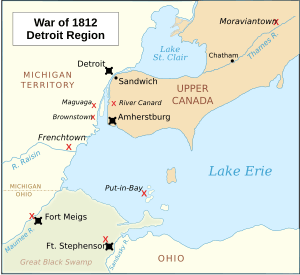Battle of Brownstown facts for kids
Quick facts for kids Battle of Brownstown |
|||||||
|---|---|---|---|---|---|---|---|
| Part of the War of 1812 | |||||||
|
|||||||
| Belligerents | |||||||
| Native Americans | |||||||
| Commanders and leaders | |||||||
| Tecumseh | Major Thomas Van Horne | ||||||
| Strength | |||||||
| 25 | 200 | ||||||
| Casualties and losses | |||||||
| 1 killed | 18 killed 12 wounded 70 missing |
||||||
The Battle of Brownstown was an early fight during the War of 1812. This battle happened on August 5, 1812. Even though the United States soldiers had more people, they lost to a smaller group of Native American warriors. The American forces had many losses, but the Native American warriors were almost unharmed.
The battle took place near Brownstown. This was a Wyandot village in Michigan. It was located south of Fort Detroit. Today, Carlson High School in Gibraltar, Michigan, is close to where the battle happened.
Why the Battle Happened
Before the War of 1812, many Native American tribes formed an alliance. They were encouraged by the British. This alliance included tribes like the Mingo, Wyandotte, Miami, Delaware, Shawnee, Kickapoo, Sauk, Ottawa, Ojibwe, Potawatomi, Mohawk, and Chickamauga. They joined together against the United States.
The main meeting place for this alliance was first in Ohio. Later, it moved to Brownstown. A Wyandot chief named Walk-in-the-Water lived in Brownstown. He and other chiefs had an agreement with the U.S. government. This agreement allowed them to live in Brownstown for 50 years.
On August 5, 1812, a group of 200 U.S. soldiers left Fort Detroit. They were led by Major Thomas Van Horne. Their mission was to travel south to the River Raisin. They needed to pick up food and supplies there. Then, they would bring these supplies back to Fort Detroit. This was for the American army, led by Brigadier General William Hull. Hull was in Canada at the time, but he would soon return to Detroit.
The Battle Begins
As the American soldiers crossed Brownstown Creek, they were suddenly attacked. About 25 Native American warriors ambushed them. These warriors were led by important chiefs. They included the Shawnee war chief Tecumseh, Chickamauga war chief Daimee, and Wyandot chief Roundhead.
Major Van Horne saw how strong the attack was. He ordered his soldiers to retreat. But the American soldiers were mostly untrained militia. They panicked and scattered. Van Horne could only keep about half of his soldiers together.
After the Fight
The battle was a clear victory for the Native American warriors. The American forces suffered heavy losses. 18 American soldiers were killed, 12 were wounded, and 70 went missing. Many of the "missing" soldiers were just separated during the chaos. They returned to Detroit in the days that followed. Only one Native American warrior was killed in the battle.
After the battle, Josiah Snelling was praised for his bravery. He was promoted to Major. Later, his statements were used in a military trial for General Hull. This happened after Hull surrendered Fort Detroit to Tecumseh's forces.
One Native American chief named Blue Jacket died in this battle. This was likely one of the sons of the more famous Shawnee chief also named Blue Jacket.
Years later, in 1813, the United States Congress passed a law. This law gave money to the families of the soldiers who died in the battle. For example, the family of Jacob Pence received over $1,300 in payments.


